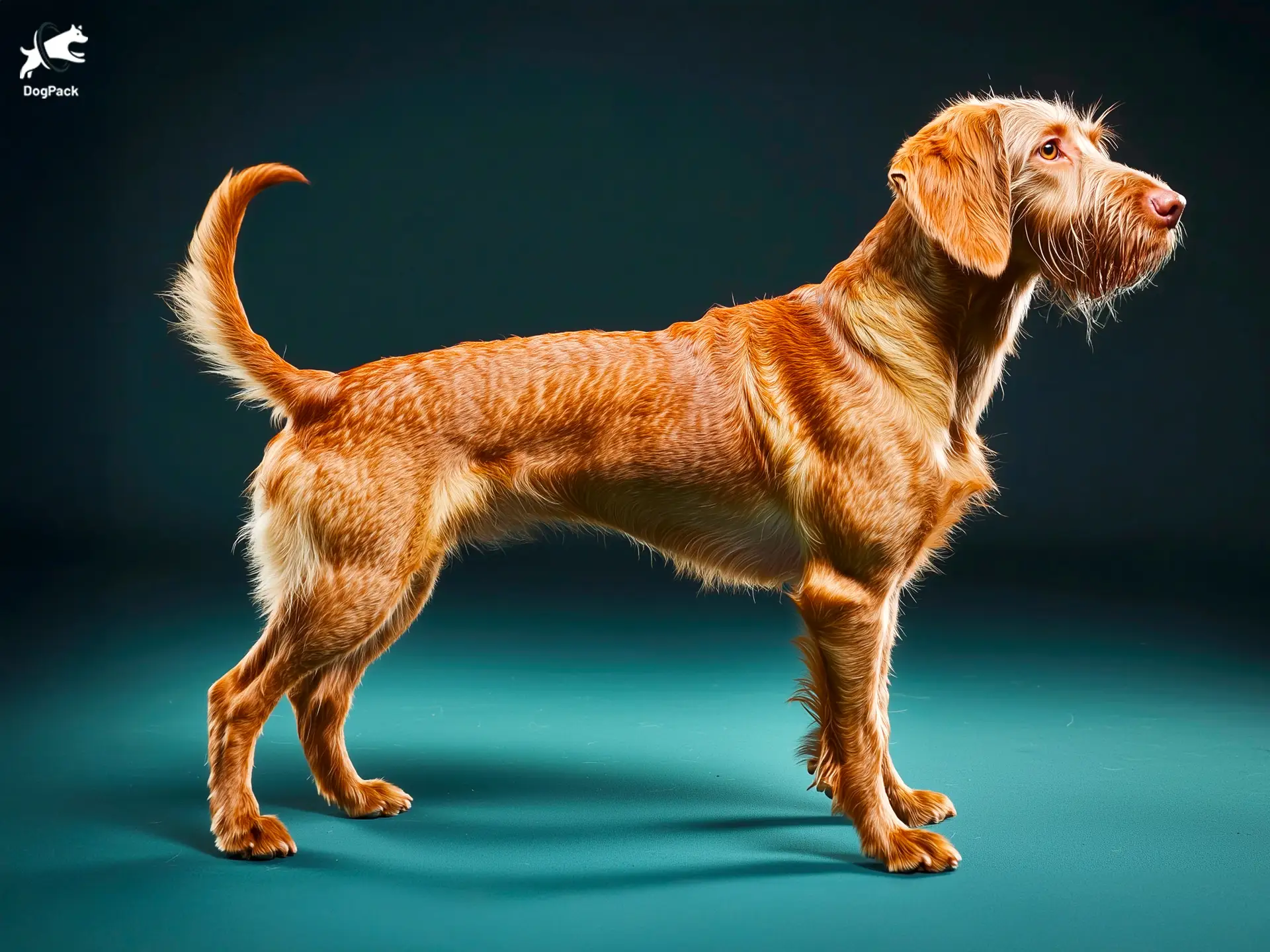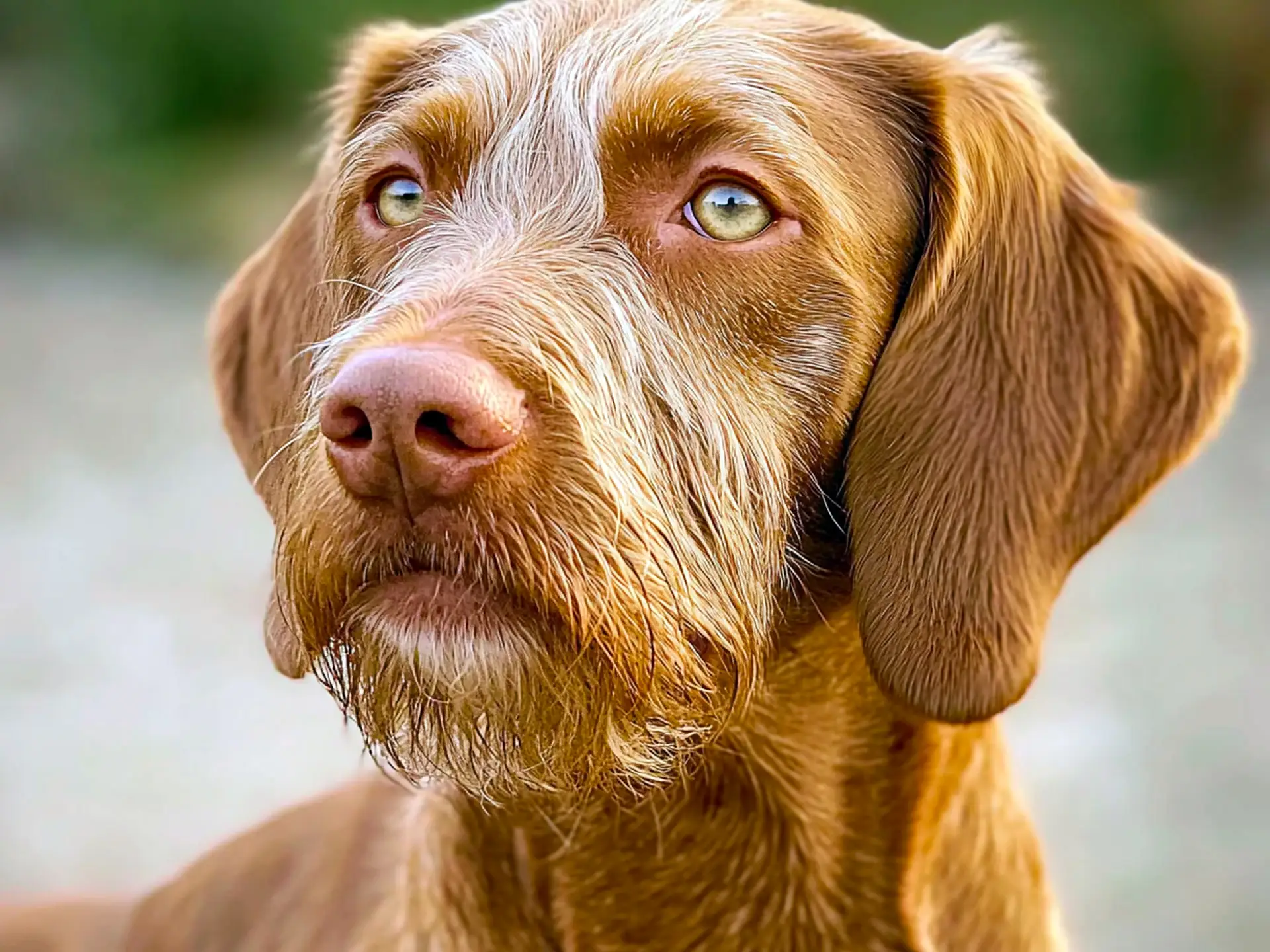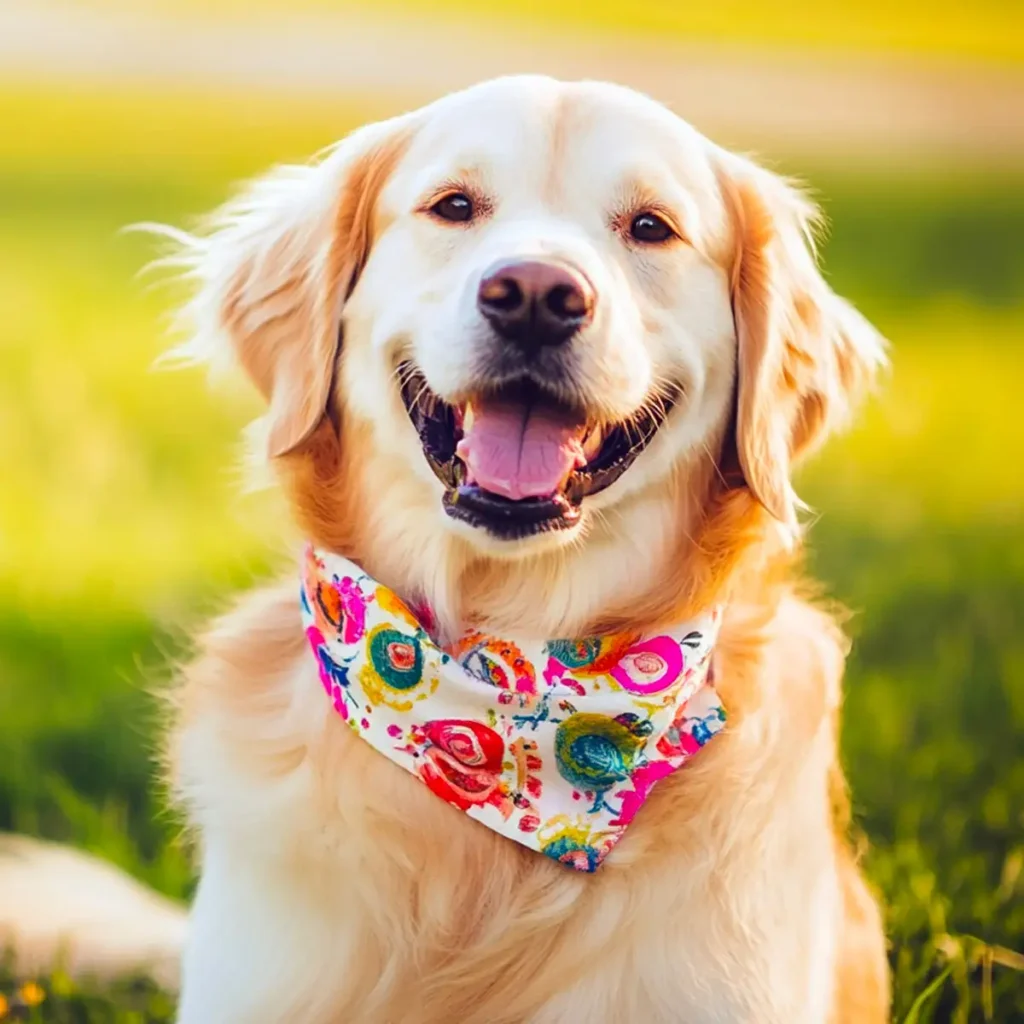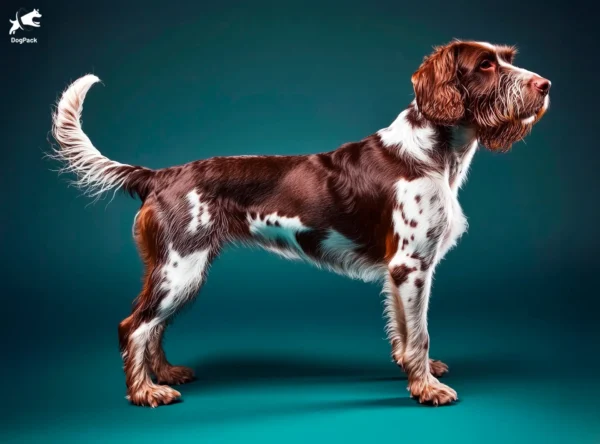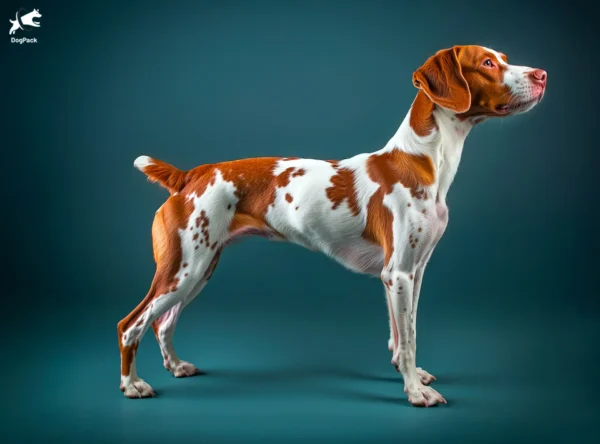Wirehaired Vizsla Dog Breed Info & Overview
The Wirehaired Vizsla, a rugged yet elegant sporting breed, combines the athleticism of the Vizsla with a dense, weather-resistant coat. Bred in Hungary for hunting and companionship, this energetic and intelligent dog thrives in active households. With a friendly personality and an adventurous spirit, the Wirehaired Vizsla is the perfect companion for those who love the outdoors and an eager, affectionate canine partner.
Characteristics
Pictures
Breed History
The story of this rugged Hungarian gundog began when breeders sought to create a versatile hunting companion with more weather resistance than the smooth-coated Vizsla. They combined the traditional Vizsla with breeds like the German Wirehaired Pointer to achieve a denser, protective coat. Over time, this new variety proved its worth in the field, tracking and retrieving game across Hungary’s varied landscapes.
In the early 20th century, Hungarian sportsmen needed a dog that could handle marshy terrain and harsher climates without sacrificing the Vizsla’s gentle temperament. The result was a diligent and fearless hunting ally. Although initially known only to dedicated enthusiasts in Hungary, the dog’s reliable work ethic soon caught the attention of hunters and families elsewhere in Europe.
By the mid-1900s, the Wirehaired Vizsla had gained modest popularity beyond Eastern Europe, eventually making its way to the United States. Here, it continued to develop a following among those looking for a loving yet highly capable field dog. Over the decades, breed clubs formed to preserve its unique characteristics. Today, it’s recognized by major kennel clubs, though it remains less common than its smooth-coated cousin.
Temperament, Personality
This breed is renowned for blending spirited energy with a heartwarming sensitivity. They crave human companionship and often shadow their favorite people around the house—earning them the nickname of “Velcro dog.” That close bond they form with their owners makes them intuitive to moods and routines, so don’t be surprised when they trot beside you, anticipating every move.
Friendly by nature, they’re generally welcoming to new faces if introduced properly. Early socialization helps them adapt to a variety of environments, ensuring they remain confident and at ease with strangers, kids, and even other pets. Their gentleness can be a real asset around children, which is why they’re frequently suggested for families seeking a loyal companion.
The Wirehaired Vizsla’s playful spirit demands both physical and mental stimulation to keep boredom at bay. They love interactive games, puzzle toys, and any chance to join family activities. While naturally gentle, they still retain a keen hunting instinct. With the right training and outlets for their energy, these dogs show tremendous adaptability, transitioning from an active day outdoors to cuddly downtime on the couch.
Physical Characteristics
You’ll notice that trademark wiry coat—slightly tousled yet protective—covering a muscular and athletic frame. This layering provides warmth in colder climates and helps repel water during fieldwork. The coat is typically russet or golden rust, with some variance in shading, and it’s often complemented by bushy eyebrows and a distinctive beard that gives the breed its charmingly scruffy appearance.
Their lean, strong build reflects a dog designed for endurance and agility, crucial traits for a versatile gundog. Males and females alike boast well-developed muscles, particularly in the chest and hindquarters, enabling them to cover ground with an effortless gait. Beyond the coat’s texture, the eyes often stand out—usually warm brown, exuding a gentle yet alert expression that few can resist.
Although they share many features with the smooth-coated Vizsla, the wirehaired version is typically a bit sturdier, especially around the shoulders. Their folded ears remain somewhat shorter than other pointing breeds, hanging close to the cheeks and adding to the breed’s overall endearing look. When fully grown, the Wirehaired Vizsla epitomizes the balance of grace and ruggedness that sporting large dog breeds often exhibit.
Health Issues
Like many active, medium-to-large sporting dogs, they can be prone to hip dysplasia. Regular check-ups, X-ray screenings, and maintaining a healthy weight help minimize the impact of this condition. Reputable breeders should test their stock to ensure lower risk factors for this genetic concern, so always ask about health clearances when considering adding one to your family.
Eye issues like entropion or ectropion can occur, where the eyelids roll inward or outward respectively. These conditions might require surgical intervention if left untreated. Keeping an eye (pun intended) on any redness or tearing is key. Additionally, some Wirehaired Vizslas may experience allergies or skin sensitivities, often manifesting as itching or dryness, which a vet can help manage with specialized care.
Regular veterinary check-ups and a balanced lifestyle are the best ways to ensure long-term health. Because they are so active, it’s essential to monitor their joints, hydration, and muscle condition—especially if they’re involved in extensive hunting or sports. Preventive care, including vaccinations and heartworm prevention, is vital, as well as early detection of any developing issues to keep these dogs healthy and ready for adventure.
Grooming Needs
Though not quite as low-maintenance as other short-haired breeds, the Wirehaired Vizsla’s coat is still relatively easy to manage. Brushing once or twice a week helps remove dead hair and distribute natural oils, keeping that wiry coat looking tip-top. A slicker brush or a bristle brush can be effective, but be gentle—their skin can be sensitive if brushed too vigorously.
Hand-stripping, a process where loose fur is plucked out by hand or with a stripping knife, is sometimes recommended to maintain coat texture. This might sound daunting, but many owners find it becomes a straightforward routine after proper instruction. Occasional trimming around the face keeps the eyebrows and beard neat, preserving that scruffy charm without letting it run wild.
Don’t forget about regular nail trims and ear checks. These pups can collect debris in their ears during hunts or hikes, so a gentle weekly inspection prevents infections. Bath time can be on an as-needed basis—over-bathing can strip the coat of essential oils. Ultimately, a consistent grooming regimen is key to keeping a Wirehaired Vizsla comfortable, healthy, and ready for each new outing.
Exercise Requirements
High-energy is an understatement for this breed. Their athletic heritage drives a near-constant desire to run, chase, and explore. Daily walks won’t cut it; aim for extended runs, off-leash play in a secure area, or even agility and nosework activities. They thrive in an environment where they can indulge in vigorous exercise, making them an excellent match for active households.
Because they were bred as multitasking hunting companions, they appreciate tasks that challenge their brains as well as their muscles. Engaging them in field trials, dock diving, or advanced obedience sessions can channel that gusto constructively. If you have access to safe open spaces, letting them roam (under reliable recall) allows them to burn energy while satisfying their curious, exploratory nature.
For families, turning exercise into fun group activities works wonders—think fetch marathons at the park, hikes in the woods, or even a canine sports class. Keep sessions varied to stave off boredom. If you can’t dedicate substantial outdoor time, puzzle toys and sniffing games indoors can help fill the gap. Ultimately, the Wirehaired Vizsla does best with at least one to two hours of daily, high-quality exercise.
Training Tips
These dogs are bright, eager to please, and quick on the uptake, but they do have an independent streak. Positive reinforcement training is crucial—harsh methods can damage their sensitive nature. Treats, praise, and consistent routines typically yield the best results. Begin with basic commands and gradually advance to specialized training if hunting or performance sports are on the agenda.
Socialization from a young age prevents potential wariness toward strangers or other animals. Gentle, structured introductions to different environments, people, and pets help them remain confident. You could consider group puppy classes, where they’ll learn both manners and how to focus around distractions. This approach also caters to their social side, as they’ll enjoy meeting fellow canines in a supervised setting.
Training sessions are more effective when they’re fun and engaging. Incorporate games like hide-and-seek or short scent trails to tap into their hunting instincts. Breaking lessons into short, focused bursts keeps them enthusiastic rather than overwhelmed. With consistency and patience, a Wirehaired Vizsla can excel in obedience, fieldwork, or dog sports, making them a versatile companion in and out of the home.
Nutrition, Diet
Because Wirehaired Vizslas burn so many calories during their high-energy escapades, they often require a nutrient-dense meal plan. Aim for a high-protein formula (around 25–30% protein) that includes quality sources like chicken, fish, or turkey. Foods should also contain healthy fats, supporting joint function and fueling their active lifestyle. Look for kibble specifically formulated for sporting or working breeds.
Puppies typically benefit from multiple small meals per day—three to four feedings help sustain their rapid growth without overloading the digestive system. As they transition to adulthood (around 12–18 months), moving to two larger meals daily is common. An adult Wirehaired Vizsla weighing about 60 pounds often eats around 2.5–3 cups of premium dog food per day, divided into two servings.
Adjust portion sizes based on your dog’s activity level. During hunting season or periods of intense training, they might require additional calories to keep up their stamina. Always monitor body condition: visible ribs might indicate underfeeding, while a thickened waistline suggests it’s time to cut back. Consult your veterinarian if you’re unsure about the right balance, as nutritional needs can vary among individuals.
Adoption, Breeders
If you’re ready to welcome one of these energetic companions into your life, adopting through a rescue organization focused on Vizslas or sporting breeds can be a wonderful choice. Rescues sometimes have young adults who are already house-trained, providing a smoother transition. But because Wirehaired Vizslas are relatively uncommon, you might have to join a waiting list.
When looking to buy, always seek out breeders who conduct health screenings, including hip and eye exams. Breeders associated with clubs like the Wirehaired Vizsla Club of America or the American Kennel Club typically follow breed standards and ethical practices. They can also offer valuable insights, from socialization tips to recommended training regimens for your new puppy.
Before making your final decision, ask plenty of questions regarding a breeder’s methods, the pup’s lineage, and any genetic testing. Reputable sources should be transparent, open to visits (where feasible), and eager to match the right puppy to the right home. If adopting, check broader networks like Petfinder for possibilities. Commitment to responsible sourcing ensures you’ll have a healthy, happy Wirehaired Vizsla from day one.
Family Pet?
Don’t let the rugged exterior fool you—these dogs can be total softies, especially around the people they know best. Families willing to provide ample physical and mental engagement will find them to be affectionate, playful, and wonderfully loyal. If your household already embraces an active routine—like weekend hikes or daily runs—this breed can fit in seamlessly.
Wirehaired Vizslas often bond particularly well with children, thriving in a home where everyone participates in playtime. Gentle, supervised interactions ensure that both the dog and kids learn proper boundaries—so tail pulling and overexcitement aren’t an issue. Thanks to their sociable nature, they can also coexist with other pets, provided everyone gets along and the introductions are done thoughtfully.
Because of their high energy, they’re best for families that can devote time every day to outdoor activities. If you have a spacious yard or live near safe parks, the dog will have ample room to roam. Frequent opportunities for exercise and mental stimulation prevent restlessness. If you’re a couch-potato household, consider a more relaxed breed, as this pup’s spirit can quickly outpace a sedentary lifestyle.
Right For You?
Ask yourself: Are you willing to provide daily exercise, mental challenges, and plenty of social time? If the answer is a resounding “yes,” then this breed might be your perfect match. Their affectionate demeanor is balanced by an unyielding need for activity, so they’ll happily trot alongside you for long runs or snuggle up after a day of exploration.
If you’re drawn to hunting or advanced dog sports, the Wirehaired Vizsla offers the best of both worlds—an easygoing family companion and a high-performance athlete. On the flip side, apartment living could pose challenges unless you’re prepared for multiple daily outings and mental enrichment. Their inquisitive nature also thrives in homes where they can roam a safely fenced yard.
Before committing, consider factors like grooming, training intensity, and space needs. They can handle cooler climates better than many short-haired breeds, but they still want to be inside with the family, not left outdoors. Ultimately, if you want a devoted buddy who excels in both sporting pursuits and family life, this energetic Hungarian dog could be the ideal fit.
Conclusion
With a strong work ethic and an even stronger desire for human companionship, the Wirehaired Vizsla stands out as a dynamic yet gentle breed. Their wiry coat and athletic build hint at their robust heritage, while their loving nature shines through in everyday family life. If you’re up for regular exercise, ongoing training, and plenty of quality time together, you’ll find this sporting partner both loyal and deeply rewarding.
FAQs
-
How is the Wirehaired Vizsla different from the Smooth Vizsla?
The Wirehaired Vizsla has a denser, wiry coat with a noticeable beard and eyebrows, providing better protection in harsh weather and rugged terrain. They are slightly stockier and more muscular than their smooth-coated counterparts, making them well-suited for hunting in rougher environments.
-
Do Wirehaired Vizslas have webbed feet?
Yes, the Wirehaired Vizsla has partially webbed feet, which aid in swimming. This makes them excellent retrievers in water, a trait inherited from their hunting background. They are strong, confident swimmers and often enjoy water-based activities.
-
How adaptable is a Wirehaired Vizsla to different climates?
Thanks to their thick, wiry double coat, Wirehaired Vizslas handle cold weather better than Smooth Vizslas. They can tolerate mild heat but should be monitored in extreme temperatures. Proper hydration and shade are essential in hot climates, while in winter, their coat provides natural insulation.
-
Can a Wirehaired Vizsla be a good off-leash dog?
With proper training, a Wirehaired Vizsla can be reliable off-leash. However, they have a strong prey drive and may chase small animals. Off-leash success requires early recall training, socialization, and controlled exposure to distractions in a safe environment.
-
Do Wirehaired Vizslas have a strong “velcro dog” personality?
Yes! Like their smooth-coated relatives, Wirehaired Vizslas are incredibly affectionate and clingy with their owners. They thrive on human interaction and do best in households where they aren’t left alone for long periods. Without companionship, they may develop separation anxiety.
Breed Ratings
The Wirehaired Vizsla boasts keen problem-solving skills and quick learning, excelling in advanced obedience and field tasks.
They love interactive games and family fun, though they can be a bit intense if not provided with outlets for their energy.
This breed is brimming with vigor and thrives on vigorous daily exercise to maintain physical and mental well-being.
While not heavy shedders, their wiry coat requires regular brushing to keep loose hairs in check.
Bred for hunting, they have a strong instinct to chase game, making focused training essential around smaller pets.
Weekly brushing and occasional hand-stripping are manageable, but more involved than with a short-haired breed.
Highly responsive to positive methods, though consistency is key for these sometimes headstrong pups.
They crave human interaction and may become anxious when left for extended periods without stimulation.
Generally moderate, though they’ll alert you to strangers or unusual activities around the home.
Not a heavy drooler, but a bit of slobber can occur after drinking or exertion.
Sociable with most dogs, especially when socialized early, but introductions should still be done carefully.
Typically robust, with a few breed-specific concerns like hip dysplasia and eye issues that responsible care can manage.

